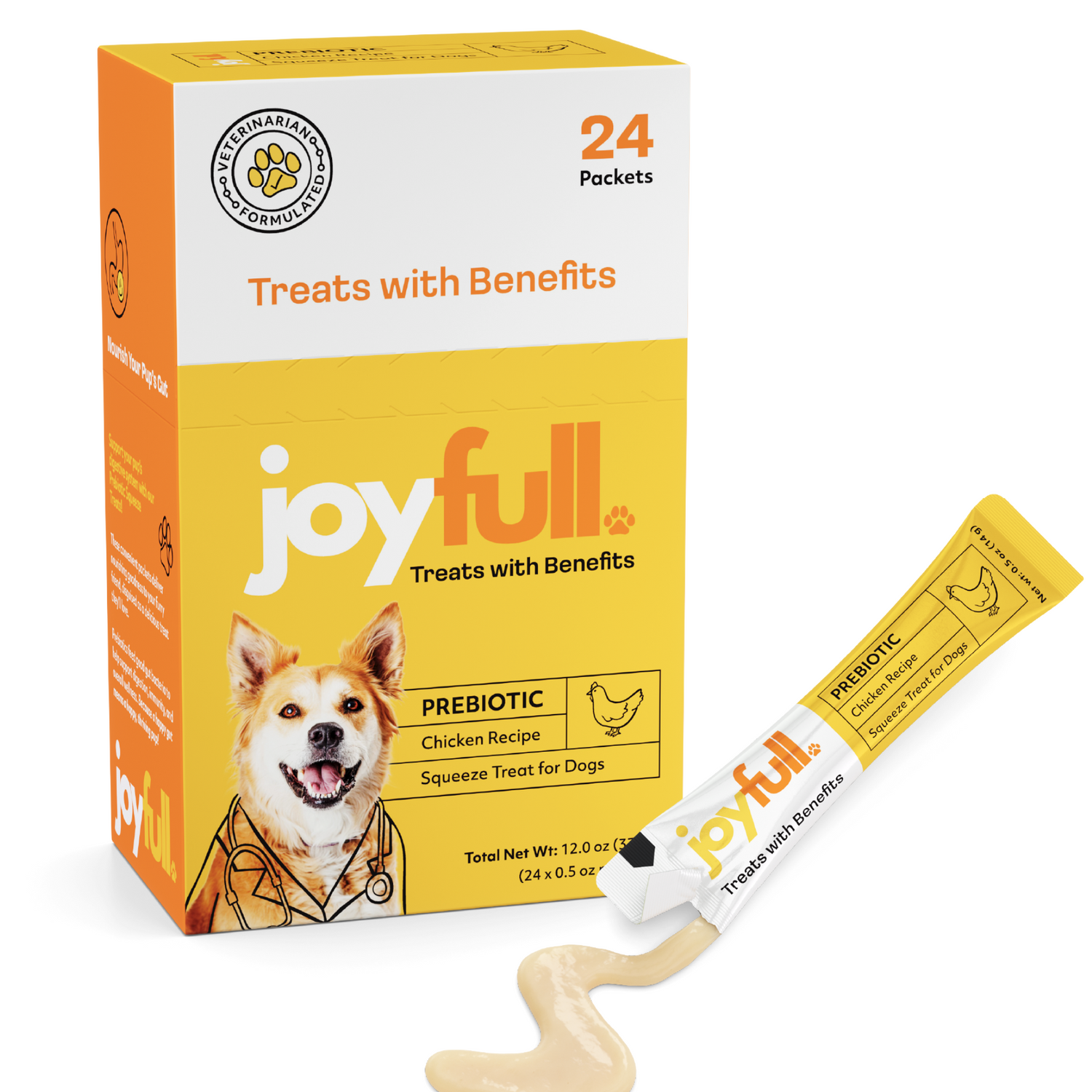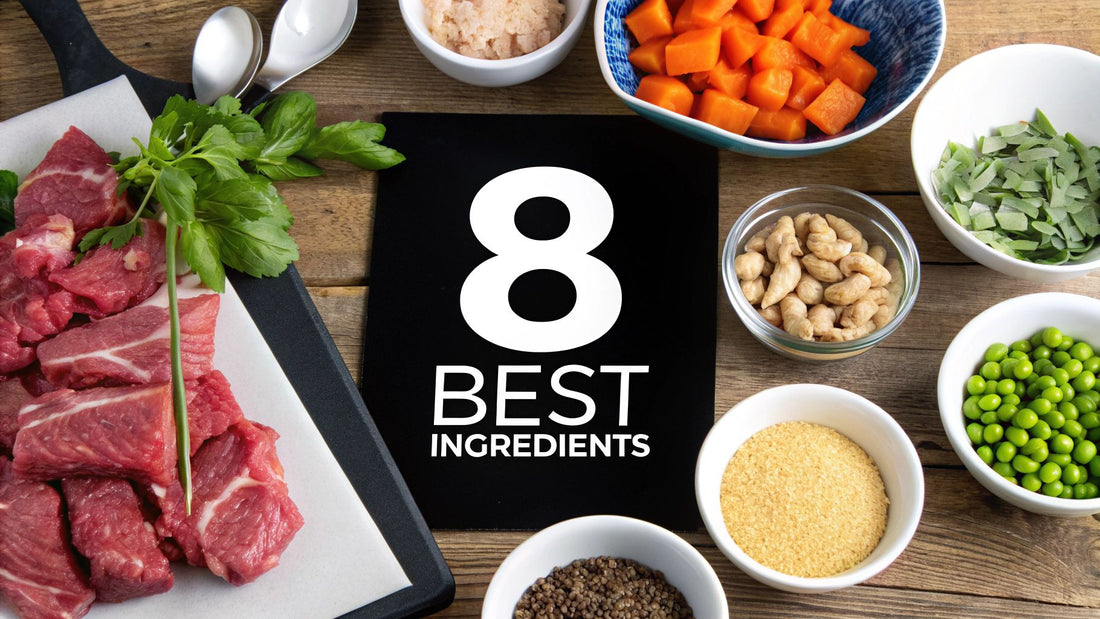
8 Best Ingredients for Homemade Dog Food (2025 Guide)
The journey to optimal canine health often starts right in your own kitchen. Many loving pet owners are now looking beyond commercial labels, seeking more control and transparency over what goes into their furry companion's bowl. The desire for clean, high-quality nutrition isn't just a human trend; our dogs deserve the same thoughtful approach to their diet.
Crafting balanced homemade dog food can seem complex, but it becomes much simpler when you understand the foundational building blocks. This guide serves as a practical blueprint, moving beyond a simple list to provide in-depth, actionable insights. We will break down the 8 best ingredients for homemade dog food, detailing not just the 'what' but the crucial 'why' and 'how' for each one.
You will learn about the specific nutritional benefits of powerhouse ingredients like lean proteins, organ meats, and omega-rich fish. We'll also cover proper preparation techniques and portioning advice to ensure safety and balance. By the end of this article, you will have the confidence and knowledge to create meals that are not only delicious but also scientifically sound and perfectly tailored to support your dog's unique health needs. Every bowl you prepare can be packed with targeted wellness.
1. Lean Proteins (Chicken, Turkey, Beef): The Foundation for Muscle & Vitality
Lean proteins are the non-negotiable cornerstone of a healthy homemade diet for dogs. As facultative carnivores, dogs are evolutionarily designed to thrive on animal-based proteins, which provide the essential amino acids required for everything from muscle development and tissue repair to immune function and hormone production. These high-quality meats are considered "complete" proteins because they contain all nine essential amino acids that a dog's body cannot produce on its own.
Why Protein is the Priority
Including lean meats like chicken, turkey, and grass-fed beef is crucial for building a diet that supports a dog's natural physiology. Leading canine nutrition experts, such as Dr. Karen Becker, consistently emphasize using organic, high-quality meats as the foundation of any whole-food diet. Commercial raw food brands known for their species-appropriate recipes, like Primal and Stella & Chewy's, often formulate their diets with up to 95% meat, organs, and bone, demonstrating the industry’s high regard for protein-centric meals. This approach ensures dogs receive the building blocks for a strong, vibrant life.
Practical Tips for Implementation
To properly incorporate this ingredient into your homemade dog food, follow these guidelines:
- Aim for 40-50% Protein: A significant portion of your dog's meal should consist of a lean protein source. This ensures they receive adequate amino acids for their daily needs.
- Rotate Protein Sources: Avoid feeding only one type of meat. Regularly rotating between chicken, turkey, beef, and even fish can help prevent the development of food sensitivities and provides a broader range of nutrients.
- Cook Thoroughly: To eliminate harmful pathogens like Salmonella and E. coli, always cook meat thoroughly unless you are following strict raw feeding safety protocols established with a veterinarian.
- Trim, Don't Remove, Fat: While you should remove excessive fat, leave a small amount. Healthy animal fats provide essential omega fatty acids that support skin, coat, and joint health.
By making high-quality lean protein the star of your dog’s bowl, you’re providing the single most important component for their long-term health and vitality. To explore a wider variety of options and their specific benefits, you can learn more about the best protein sources for dogs.
2. Sweet Potatoes: Digestive Health & Complex Carbohydrates
Sweet potatoes are a powerhouse carbohydrate, offering a slow-release source of energy that keeps dogs feeling full and energized. Unlike simple grains that can cause blood sugar spikes, these nutrient-dense tubers provide dietary fiber, essential vitamins, and powerful antioxidants. They are rich in beta-carotene, a precursor to Vitamin A, which is crucial for vision, immune function, and skin health, making them one of the best ingredients for homemade dog food.
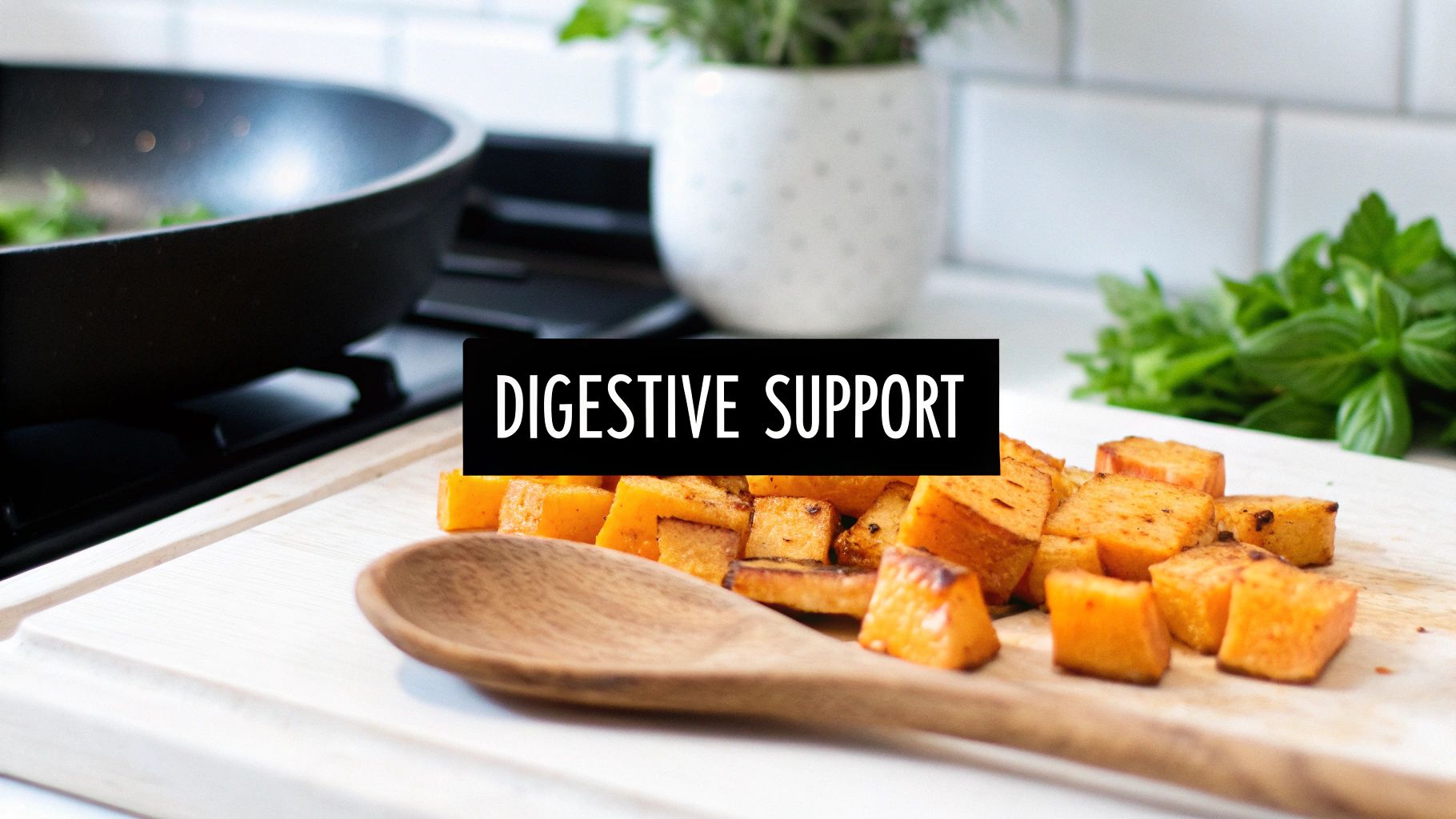
Why Carbohydrate Quality Matters
Incorporating a high-quality, complex carbohydrate like sweet potato is key for creating a balanced and easily digestible meal. Canine nutrition experts like Dr. Barbara Royal often recommend them for their prebiotic fiber, which feeds beneficial gut bacteria and supports robust digestive health. Premium commercial brands such as Open Farm and Orijen frequently use sweet potatoes as a primary carbohydrate source, highlighting their industry-wide recognition for providing sustained energy and superior nutrition without the common allergens associated with grains.
Practical Tips for Implementation
To properly incorporate this ingredient into your homemade dog food, follow these guidelines:
- Aim for 10-15% of the Meal: Carbohydrates should be a smaller, supporting component of the diet, providing energy and fiber without displacing essential proteins and fats.
- Cook Until Soft: Raw sweet potatoes can be difficult for dogs to digest. Always cook them thoroughly by baking or steaming to improve digestibility and nutrient absorption. Boiling can leach out valuable water-soluble vitamins.
- Introduce Gradually: If your dog is not used to fiber-rich foods, introduce sweet potatoes slowly over several days to prevent digestive upset like gas or loose stools.
- Store Properly: Cooked sweet potato can be mashed and stored in the refrigerator for up to five days, making it a convenient ingredient for meal prepping.
By including well-cooked sweet potatoes in your dog's meals, you provide a safe, effective, and nutrient-rich source of carbohydrates that supports both energy levels and long-term digestive wellness.
3. Leafy Greens (Spinach, Kale, Broccoli): Immune Support & Detoxification
While protein forms the foundation, nutrient-dense vegetables like spinach, kale, and broccoli are essential supporting players in a well-rounded homemade dog food. These powerful greens deliver a concentrated source of vitamins, minerals, and antioxidants that are often missing from processed kibble. Their high fiber content supports digestive health, while their unique plant compounds, or phytonutrients, offer benefits ranging from detoxification to cellular protection.
Why Protein is the Priority
Incorporating a small percentage of leafy greens and cruciferous vegetables is a key strategy for elevating a homemade diet from merely adequate to truly optimal. Leading holistic veterinarians like Dr. Karen Becker strongly advocate for rotating a variety of greens to provide a wide spectrum of phytonutrients that support immune function. Publications like The Whole Dog Journal also recommend that 5-10% of a whole-food diet consist of vegetable matter, highlighting their role in providing key vitamins and fiber that contribute to overall wellness and disease prevention.
Practical Tips for Implementation
To properly incorporate these ingredients into your homemade dog food, follow these guidelines:
- Aim for 5-10% of the Meal: Vegetables should complement, not replace, the core protein and fat components. A small portion is all that's needed to deliver potent nutritional benefits.
- Lightly Cook & Puree: Gently steaming or blanching greens makes them easier to digest and helps reduce compounds like goitrogens in cruciferous vegetables. Pureeing or finely chopping them breaks down the cellulose, allowing your dog to absorb the maximum amount of nutrients.
- Rotate Varieties: Switch between kale, spinach, broccoli, Brussels sprouts, and green beans. This rotation ensures a diverse nutrient intake and minimizes the risk of any single compound building up.
- Know When to Avoid: For dogs with a history of kidney disease or calcium oxalate bladder stones, it's best to avoid high-oxalate greens like spinach. Consult your veterinarian for guidance.
By adding a colorful variety of leafy greens, you are directly boosting your dog’s immune system and providing some of the best ingredients for homemade dog food that support long-term cellular health.
4. Salmon & Fish Oil - Omega-3 Fatty Acids & Cognitive Function
Fatty fish like salmon and high-quality fish oil supplements are powerhouses of omega-3 fatty acids, specifically eicosapentaenoic acid (EPA) and docosahexaenoic acid (DHA). These polyunsaturated fats are essential for a dog's health, playing a critical role in everything from brain development in puppies to maintaining cognitive function in seniors. Unlike some other nutrients, a dog's body cannot efficiently produce these fats, making their inclusion in a homemade diet one of the best ways to support overall wellness.
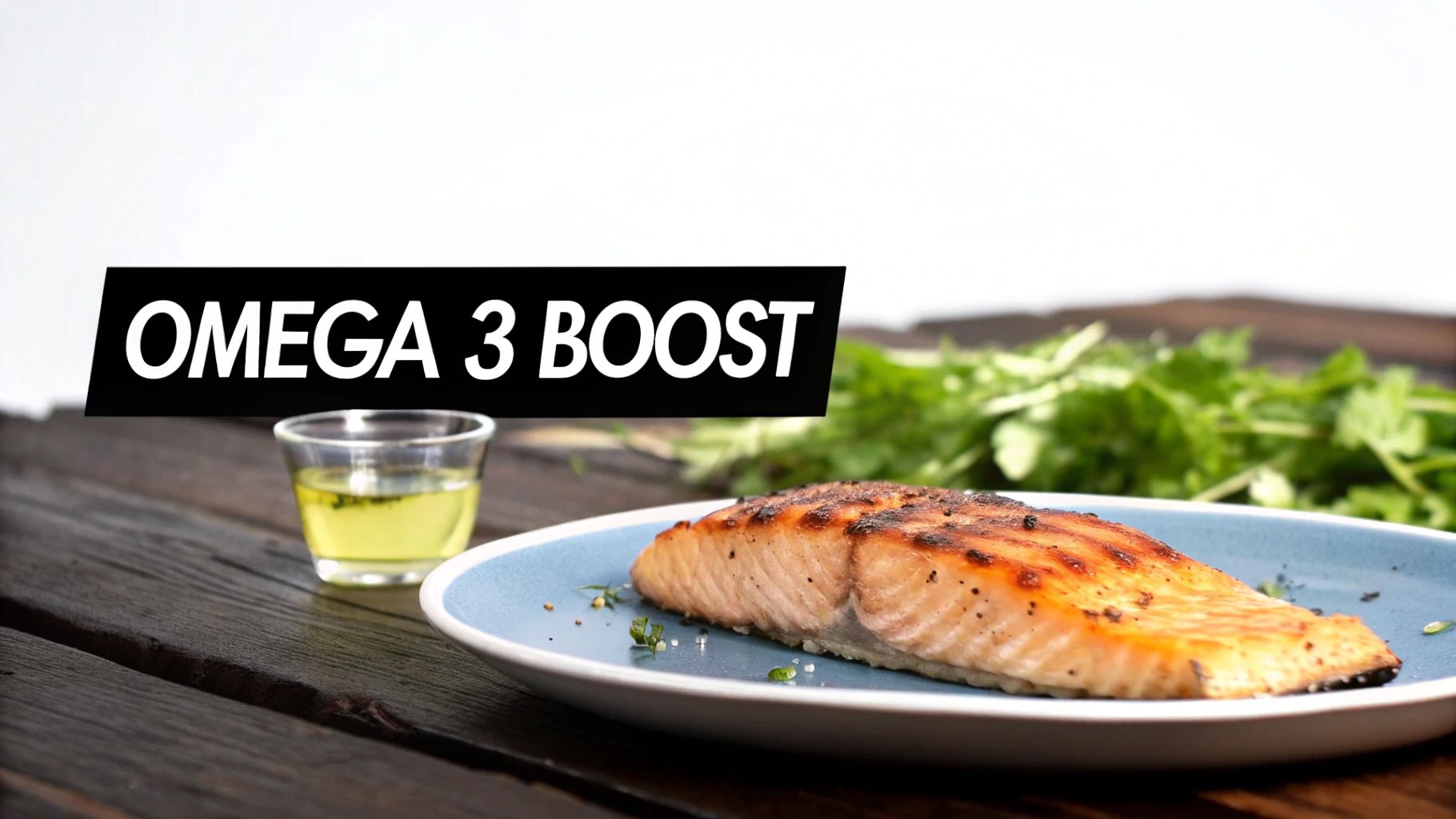
Why Omega-3s are a Priority
The anti-inflammatory properties of EPA and DHA are among the most well-researched benefits in canine nutrition. Leading pet food brands like Hill's Science Diet and Royal Canin specifically enrich their senior and mobility formulas with fish oil to help manage joint inflammation and support brain health. A landmark University of Michigan study demonstrated that supplementing aging dogs' diets with fish oil improved their cognitive function. This research underscores why many veterinarians recommend trusted supplement brands like Nordic Naturals and Vital Planet as vital additions to a dog’s diet, providing a targeted way to reduce inflammation and protect cellular health.
Practical Tips for Implementation
To properly incorporate this ingredient into your homemade dog food, follow these guidelines:
- Serve Fresh Fish or Supplement: You can include cooked, deboned salmon in your dog's meals two to three times per week. Alternatively, add a high-quality fish oil supplement daily.
- Dose Carefully: For supplements, a general guideline is to provide 100-200mg of combined EPA and DHA per 10 pounds of body weight. Always confirm the correct dosage with your veterinarian.
- Proper Storage is Key: Omega-3 fatty acids are prone to oxidation, which makes them less effective. Store fish oil in a cool, dark place or in the refrigerator to preserve its potency.
- Choose Wild-Caught: When possible, opt for wild-caught salmon over farmed varieties, as it typically offers a higher concentration of beneficial omega-3s and fewer contaminants.
By integrating salmon or fish oil, you are providing some of the best ingredients for homemade dog food, directly supporting your dog’s brain, joints, and skin. To understand more about safely including fish in their diet, you can learn more about the benefits of fish for dogs.
5. Organ Meats (Liver, Kidney, Heart): Nutrient Density & Micronutrients
Often overlooked, organ meats are nature’s multivitamins and a critical component of the best ingredients for homemade dog food. While muscle meat provides the protein foundation, organs like liver, kidney, and heart deliver an unparalleled concentration of essential vitamins and minerals. These nutrient-dense powerhouses are far superior to muscle meat in terms of micronutrient content, offering a potent source of everything from iron and zinc to vital B vitamins.
Why Protein is the Priority
Including organ meats mirrors the ancestral diet of canines, who would naturally consume the entire animal, organs first. Proponents of Biologically Appropriate Raw Food (BARF) diets, like its founder Dr. Ian Billinghurst, emphasize that organs are non-negotiable for a complete diet. Liver, for example, is exceptionally rich in vitamin A, B vitamins (especially B12), iron, and copper, which support everything from vision and red blood cell production to metabolic function. This "nose-to-tail" approach ensures a dog receives a full spectrum of nutrients that muscle meat alone cannot provide.
Practical Tips for Implementation
To properly incorporate this ingredient into your homemade dog food, follow these guidelines:
- Limit to 5-10%: Organ meats should make up about 5-10% of the total meat portion of your dog's meal. Too much, especially liver, can lead to vitamin A toxicity or digestive upset.
- Introduce Gradually: Start with a very small amount and slowly increase the portion over a week to allow your dog’s digestive system to adjust to the richness.
- Rotate Organ Types: Offer a variety of organs, including liver, kidney, heart, spleen, and pancreas. This provides a broader range of nutrients and mimics a more natural feeding pattern.
- Source High-Quality Meats: Always purchase organs from trusted, reputable sources, such as local butchers or farms that raise grass-fed, pasture-raised animals, to ensure purity and quality.
By strategically including a small, balanced portion of organ meats, you can significantly enhance the nutritional value of your dog’s homemade meals. To understand more about the specific vitamins these ingredients provide, you can learn about the most important homemade dog food vitamins.
6. Bone Broth: Gut Health & Joint Support
Bone broth is a nutrient-dense powerhouse, a liquid gold created by slow-simmering animal bones. This gentle cooking process breaks down collagen into gelatin and releases a wealth of easily absorbable nutrients like amino acids (glycine, proline), glucosamine, and essential minerals. These components are vital for maintaining a healthy gut lining, supporting joint cartilage, and bolstering the immune system, making it one of the best ingredients for homemade dog food, especially for senior pets or those with digestive sensitivities.
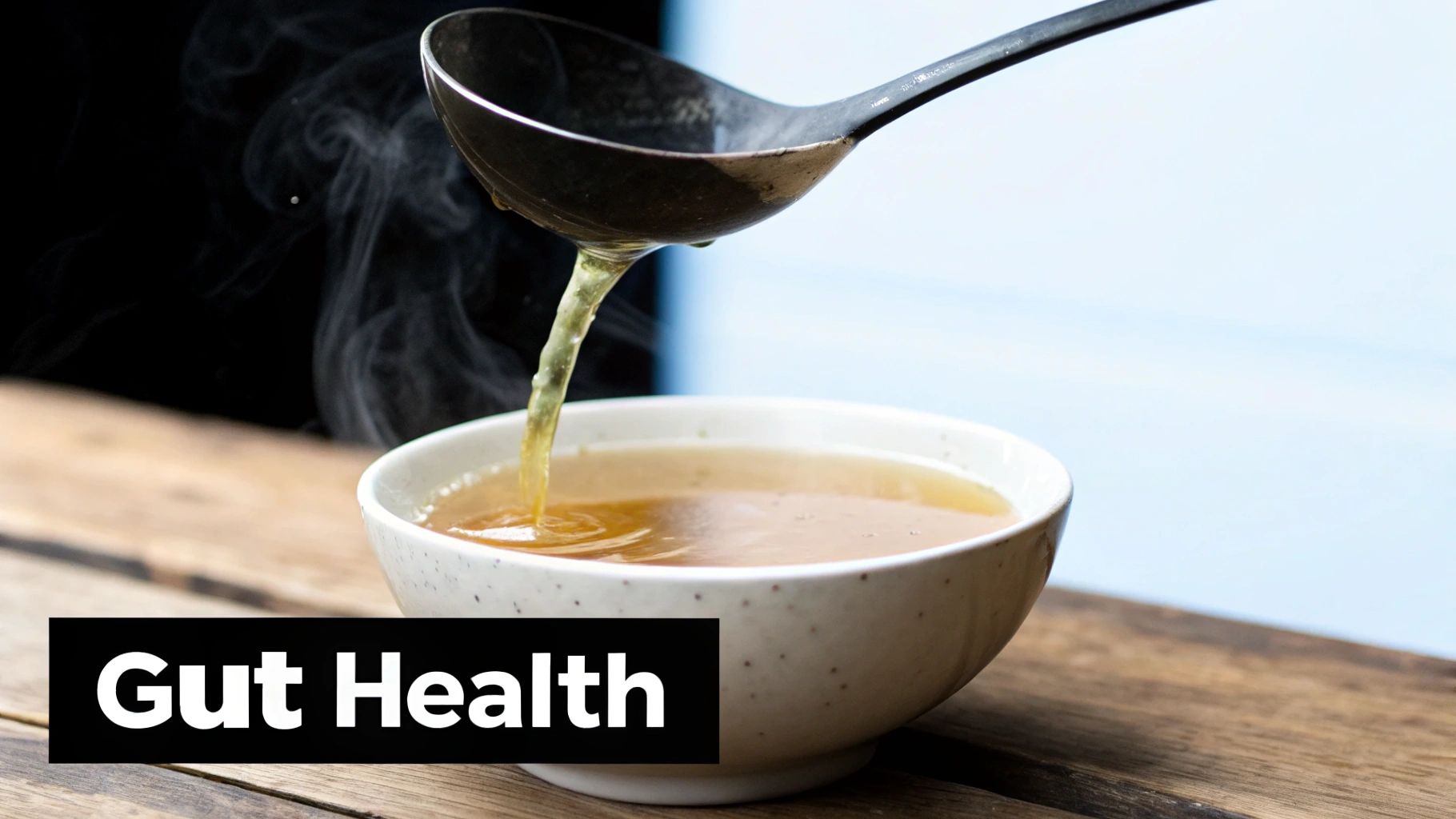
Why Bone Broth is a Priority
The unique nutritional profile of bone broth makes it incredibly supportive for a dog's foundational health systems. Veterinary gastroenterologists often recommend it for dogs with inflammatory bowel disease (IBD) due to its gut-soothing properties. The popularity of Dr. Josh Axe’s 'Bone Broth Diet' for humans has crossed over to the pet world, highlighting its recognized benefits. High-quality commercial options like Primal and Mountain Peaks offer convenient broths, showcasing the ingredient's value in a species-appropriate diet.
Practical Tips for Implementation
To properly incorporate this ingredient into your homemade dog food, follow these guidelines:
- Simmer Low and Slow: Make your own by simmering bones from pasture-raised animals for 24-48 hours. This long, slow cook is essential for extracting maximum nutrients.
- Add Apple Cider Vinegar: A splash of apple cider vinegar in the pot helps pull more minerals from the bones into the broth.
- Remove the Fat: After cooking and cooling, a layer of fat will solidify on top. Scrape this off completely before feeding to avoid triggering pancreatitis in sensitive dogs.
- Freeze for Convenience: Pour the finished broth into ice cube trays and freeze. These cubes can be easily added to meals as a hydrating and nutrient-rich topper. Never add salt, onions, or other harmful seasonings.
7. Carrots & Pumpkin: Fiber for Digestive Regularity
Carrots and pumpkin are powerful, low-calorie additions that provide essential fiber to support your dog’s digestive system. This soluble and insoluble fiber blend helps maintain gastrointestinal regularity, making it a go-to remedy for both constipation and diarrhea. These vegetables are more than just fillers; they are functional ingredients that promote a healthy gut microbiome by feeding beneficial bacteria, which is why they are some of the best ingredients for homemade dog food.
Why Fiber is the Priority
Including vegetables like carrots and pumpkin is crucial for digestive balance and nutrient absorption. Veterinary clinics frequently recommend 100% pure pumpkin as a first-line treatment for mild GI upset due to its ability to firm up loose stool or soften hard stool. Beyond digestion, carrots offer beta-carotene (a precursor to Vitamin A) and vitamin K, while their crunchy texture helps clean teeth when served raw. Pumpkin provides a prebiotic boost, ensuring the gut environment is primed for optimal health.
Practical Tips for Implementation
To properly incorporate this ingredient into your homemade dog food, follow these guidelines:
- Aim for 5-10% Vegetables: This portion of your dog's meal should consist of fiber-rich vegetables like carrots or pumpkin to support digestion without displacing essential proteins and fats.
- Use 100% Pure Pumpkin: Always choose pure, unsweetened pumpkin purée, not pumpkin pie filling, which contains harmful sugars and spices like nutmeg.
- Start Small for Tummy Troubles: For digestive issues, begin with one tablespoon of pumpkin per 10 pounds of body weight and adjust as needed.
- Ensure Safe Serving Sizes: When feeding raw carrots, cut them into bite-sized pieces appropriate for your dog's mouth to prevent a choking hazard. Lightly steaming them is also a great option.
By adding these powerhouse vegetables, you are directly supporting your dog’s digestive tract and overall wellness. To ensure the freshest, most nutritious carrots for your dog's diet, you can even explore growing your own carrots at home.
8. Eggs: The Complete Protein & Choline Powerhouse
Often called nature's perfect protein, eggs are one of the most complete, cost-effective, and bioavailable ingredients for homemade dog food. They provide a full spectrum of essential amino acids required for a dog’s bodily functions, with a digestibility rating of over 90%. Beyond protein, eggs are a nutritional powerhouse, packed with vital nutrients like choline for brain and liver health, selenium for antioxidant support, and lutein for maintaining eye health.
Why Eggs are a Superior Nutrient Source
Including whole eggs in a dog's diet adds a dense source of highly usable nutrition that supports cognitive function and metabolic health. Renowned holistic veterinarian Dr. Karen Becker frequently recommends adding one to three eggs per week as a powerful nutritional boost. Ancestral and BARF (Biologically Appropriate Raw Food) diets also regularly feature eggs as a key component, mimicking the natural diet of a canine ancestor who would have scavenged for this valuable food source. This widespread endorsement highlights their role in a well-rounded, species-appropriate diet.
Practical Tips for Implementation
To safely and effectively add this ingredient to your homemade dog food, consider the following guidelines:
- Serve 1-3 Eggs Weekly: Adjust the amount based on your dog's size. A small dog might get one egg per week, while a large breed could have three.
- Cook for Safety: Cooking eggs deactivates avidin, a protein in egg whites that can interfere with biotin absorption. Scrambled or hard-boiled eggs are excellent, safe options.
- Always Include the Yolk: The yolk contains most of the key nutrients, including choline, fat-soluble vitamins (A, D, E, K), and healthy fats. Never feed only egg whites.
- Choose High-Quality Sources: Whenever possible, opt for eggs from pasture-raised or free-range hens, as they tend to have a superior nutritional profile, including higher levels of omega-3 fatty acids.
Top 8 Homemade Dog Food Ingredients Comparison
| Item | Implementation Complexity 🔄 | Resource Requirements ⚡ | Expected Outcomes 📊⭐ | Ideal Use Cases 💡 | Key Advantages ⭐ |
|---|---|---|---|---|---|
| Lean Proteins (Chicken, Turkey, Beef) | Moderate 🔄 — trimming, safe handling, cook/raw decisions | Moderate ⚡ — fresh meat, refrigeration, bulk purchase | ⭐⭐⭐⭐ — muscle development, tissue repair, coat health | Primary meal base for active/adult dogs; rotate proteins weekly | Complete amino acids, high bioavailability, palatable |
| Sweet Potatoes | Low 🔄 — cook until soft, mash or cube | Low ⚡ — inexpensive, shelf-stable when stored | ⭐⭐⭐ — sustained energy, digestive fiber, micronutrients | Complex-carb base for sensitive dogs or energy needs (10–15% of meal) | Beta‑carotene, fiber, hypoallergenic for most dogs |
| Leafy Greens (Spinach, Kale, Broccoli) | Low–Moderate 🔄 — chop/steam to reduce goitrogens | Low ⚡ — small volumes, fresh or frozen | ⭐⭐⭐ — immune support, antioxidants, low calorie | Supplement for micronutrients, weight management (5–10% of meal) | High vitamins/minerals and phytonutrients for detox/support |
| Salmon & Fish Oil | Low 🔄 — add cooked fish or dose supplement | Moderate ⚡ — quality supplements, refrigeration, cost | ⭐⭐⭐⭐ — EPA/DHA benefits: joints, brain, skin | Joint support, senior cognitive health, skin/coat issues (2–3× weekly) | Rich source of EPA/DHA omega‑3s; anti‑inflammatory |
| Organ Meats (Liver, Kidney, Heart) | Moderate 🔄 — source carefully, limit portions (5–10%) | Low ⚡ — often inexpensive but needs proper storage | ⭐⭐⭐⭐ — dense micronutrient boost (iron, B‑vitamins, A) | Micronutrient supplementation in whole/ raw diets | Extremely nutrient‑dense; small amounts yield big benefits |
| Bone Broth | High 🔄 — long simmer (12–48h), strain, de‑fat | Moderate ⚡ — bones, time, storage/freezing space | ⭐⭐⭐ — gut lining support, joint collagen, meal palatability | GI recovery, hydration, elderly/joint‑compromised dogs | Collagen/gelatin and bioavailable minerals; improves hydration |
| Carrots & Pumpkin | Low 🔄 — simple prep; cut appropriately to avoid choking | Low ⚡ — cheap, shelf‑stable (canned/puree with caution) | ⭐⭐⭐ — fiber for stool regulation; supports microbiome | First‑line GI support for diarrhea/constipation; low‑cal fillers | High fiber, beta‑carotene; versatile and safe for most dogs |
| Eggs | Low 🔄 — cook or feed raw cautiously; introduce gradually | Low ⚡ — inexpensive, widely available | ⭐⭐⭐⭐ — complete protein, choline for brain/liver | Supplementary protein and cognitive support (1–3 eggs/week) | Complete amino acid profile, highly digestible, nutrient‑dense |
Bringing It All Together for a JoyFull Bowl
Navigating the world of canine nutrition can feel complex, but as we have explored, the foundation of a healthy, homemade diet rests on a core group of powerful, whole-food ingredients. By understanding the specific benefits of lean proteins, complex carbohydrates like sweet potatoes, and nutrient-dense organ meats, you've taken the first critical step toward transforming your dog's mealtime from simple sustenance to targeted nourishment. The journey to crafting the perfect bowl is one of balance, variety, and observation.
Remember, the goal is not to use every ingredient in every meal, but to create a rotational menu that provides a wide spectrum of vitamins, minerals, and fatty acids over time. The best ingredients for homemade dog food work in synergy. The omega-3s in salmon support the joint health benefits of bone broth, while the fiber in pumpkin and carrots aids the digestion of rich proteins like beef and eggs. This holistic approach ensures your dog receives a well-rounded nutritional profile that supports everything from muscle maintenance to cognitive function.
Key Takeaways for Your Kitchen
To synthesize the information from this guide, keep these core principles at the forefront of your meal preparation:
- Protein is Paramount: Always start with a high-quality lean protein source like chicken, turkey, or beef. These form the building blocks for a strong, healthy body.
- Embrace Colorful Veggies: Incorporate a rotating cast of vegetables. Leafy greens like spinach offer immune support, while orange vegetables like carrots and sweet potatoes provide essential vitamins and fiber.
- Don't Forget Healthy Fats: Ingredients like salmon, fish oil, and eggs are crucial for providing omega-3 and omega-6 fatty acids, which are vital for skin, coat, and brain health.
- Nutrient-Dense Additions: Supercharge meals with small amounts of organ meats for concentrated vitamins and minerals, or add a splash of bone broth for a gut-friendly, hydrating boost.
Your Actionable Next Steps
Armed with this knowledge, your path forward is clear. Begin by selecting two or three ingredients from our list that you feel comfortable with and start incorporating them into a balanced recipe. Monitor your dog closely. Pay attention to their energy levels, coat condition, and digestive regularity. These observations are your most valuable feedback loop, telling you what works best for their unique system.
Most importantly, the transition to homemade dog food should be a partnership with a professional. Before making any significant dietary changes, schedule a consultation with your veterinarian or a board-certified veterinary nutritionist. They can help you fine-tune recipes to meet the specific requirements of your dog's age, breed, and any existing health conditions, ensuring a complete and balanced diet. By combining your dedication with expert guidance, you are truly providing the ultimate gift: a foundation for a long, vibrant, and joyful life with your beloved companion.
Ready to provide premium nutrition without the prep work? Joyfull uses many of the powerhouse ingredients discussed here in our perfectly balanced, gently cooked recipes. Visit Joyfull to explore our meal plans and give your dog the wholesome goodness they deserve, delivered right to your door.
